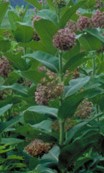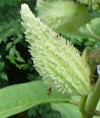 Common milkweed is native to most of the United States east of the Rocky Mountains. It prefers full sun, fertile soil, and mesic conditions but tolerates much less and can be found on both clay and sandy soils and partial sun. The plant is a common colonizer of disturbed sites and can be found in fields, pastures, vacant lots, roadsides, gardens and similar habitats.
Common milkweed is native to most of the United States east of the Rocky Mountains. It prefers full sun, fertile soil, and mesic conditions but tolerates much less and can be found on both clay and sandy soils and partial sun. The plant is a common colonizer of disturbed sites and can be found in fields, pastures, vacant lots, roadsides, gardens and similar habitats.
 Description: A single, erect, rarely branched stem arises from the ground in spring. It is pale green when young but may become reddish with maturity. The large, coarse opposite leaves are 8” long by 4” wide and are broadly oblong.
Description: A single, erect, rarely branched stem arises from the ground in spring. It is pale green when young but may become reddish with maturity. The large, coarse opposite leaves are 8” long by 4” wide and are broadly oblong.  They are simple, have smooth margins, and bear woolly hairs on their undersides. Both leaves and stems emit a milky sap when broken. Clusters of small pink to purple
They are simple, have smooth margins, and bear woolly hairs on their undersides. Both leaves and stems emit a milky sap when broken. Clusters of small pink to purple  fragrant flowers are borne in 2.5”-4” umbels at the tips of branches and in leaf axils during the summer. Tear drop-shaped, hairy or spiny seed pods, 3”-4” long, are filled with brown, round, flattened seeds that bear white silky hairs facilitating wind seed dispersal. The root system is rhizomaceous.
fragrant flowers are borne in 2.5”-4” umbels at the tips of branches and in leaf axils during the summer. Tear drop-shaped, hairy or spiny seed pods, 3”-4” long, are filled with brown, round, flattened seeds that bear white silky hairs facilitating wind seed dispersal. The root system is rhizomaceous.

 Control: The biggest problem with controlling common milkweed is the rhizomaceous root system. It must be completely removed or it will sprout and send up new plants. The best way to do this is to start digging about a foot from the base of the plant, digging all the way around and as deeply as possible. Mow areas where common milkweed infestations are great and then dig the roots in the fall. Never roto-till areas where common milkweed is growing because you may spread bits of root to new areas and spread the infestation. To control seed dispersal, cut down plants as they flower.
Control: The biggest problem with controlling common milkweed is the rhizomaceous root system. It must be completely removed or it will sprout and send up new plants. The best way to do this is to start digging about a foot from the base of the plant, digging all the way around and as deeply as possible. Mow areas where common milkweed infestations are great and then dig the roots in the fall. Never roto-till areas where common milkweed is growing because you may spread bits of root to new areas and spread the infestation. To control seed dispersal, cut down plants as they flower.